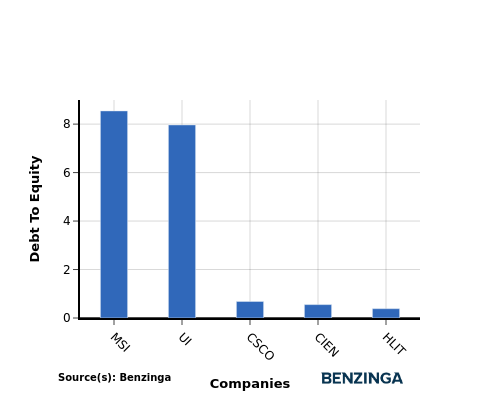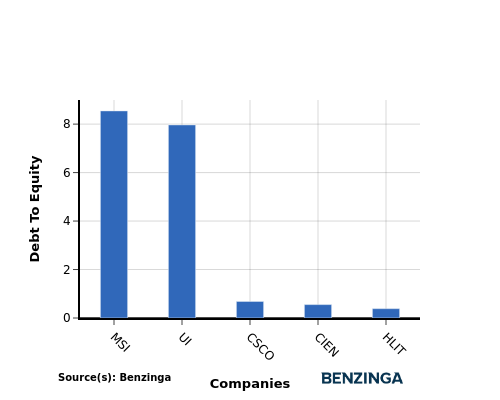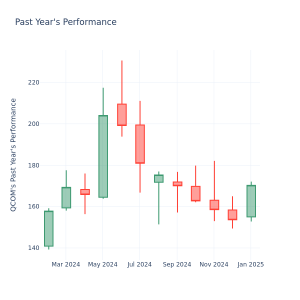
In today’s rapidly changing and fiercely competitive business landscape, it is essential for investors and industry enthusiasts to thoroughly analyze companies. In this article, we will conduct a comprehensive industry comparison, evaluating Cisco Systems CSCO against its key competitors in the Communications Equipment industry. By examining key financial metrics, market position, and growth prospects, we aim to provide valuable insights for investors and shed light on company’s performance within the industry.
Cisco Systems Background
Cisco Systems is the largest provider of networking equipment in the world and one of the largest software companies in the world. Its largest businesses are selling networking hardware and software (where it has leading market shares) and cybersecurity software such as firewalls. It also has collaboration products, like its Webex suite, and observability tools. It primarily outsources its manufacturing to third parties and has a large sales and marketing staff—25,000 strong across 90 countries. Overall, Cisco employs 80,000 people and sells its products globally.
| Company | P/E | P/B | P/S | ROE | EBITDA (in billions) | Gross Profit (in billions) | Revenue Growth |
|---|---|---|---|---|---|---|---|
| Cisco Systems Inc | 20.46 | 4.56 | 3.92 | 4.74% | $3.64 | $8.78 | -10.27% |
| Motorola Solutions Inc | 51.82 | 92.07 | 7.26 | 66.97% | $0.75 | $1.34 | 9.36% |
| Nokia Oyj | 22.66 | 1 | 1.06 | -0.69% | $0.7 | $1.94 | -17.87% |
| Ubiquiti Inc | 37.53 | 138.22 | 6.81 | 171.67% | $0.14 | $0.2 | 3.33% |
| Juniper Networks Inc | 54.79 | 2.84 | 2.50 | 0.76% | $0.11 | $0.69 | -16.82% |
| F5 Inc | 23.63 | 4.24 | 4.70 | 4.85% | $0.19 | $0.56 | -1.02% |
| Ciena Corp | 62.48 | 2.93 | 2.14 | 0.49% | $0.07 | $0.4 | -11.76% |
| Calix Inc | 1303.33 | 3.41 | 2.76 | -1.06% | $-0.01 | $0.11 | -24.09% |
| Harmonic Inc | 29.29 | 4.16 | 2.91 | -3.13% | $-0.01 | $0.07 | -11.04% |
| Digi International Inc | 58.54 | 1.74 | 2.31 | 1.74% | $0.02 | $0.06 | -6.27% |
| Aviat Networks Inc | 20.11 | 1.09 | 0.71 | 1.33% | $0.01 | $0.04 | 33.7% |
| Average | 166.42 | 25.17 | 3.32 | 24.29% | $0.2 | $0.54 | -4.25% |
Through a thorough examination of Cisco Systems, we can discern the following trends:
-
At 20.46, the stock’s Price to Earnings ratio is 0.12x less than the industry average, suggesting favorable growth potential.
-
Considering a Price to Book ratio of 4.56, which is well below the industry average by 0.18x, the stock may be undervalued based on its book value compared to its peers.
-
With a relatively high Price to Sales ratio of 3.92, which is 1.18x the industry average, the stock might be considered overvalued based on sales performance.
-
The Return on Equity (ROE) of 4.74% is 19.55% below the industry average, suggesting potential inefficiency in utilizing equity to generate profits.
-
The company has higher Earnings Before Interest, Taxes, Depreciation, and Amortization (EBITDA) of $3.64 Billion, which is 18.2x above the industry average, indicating stronger profitability and robust cash flow generation.
-
The company has higher gross profit of $8.78 Billion, which indicates 16.26x above the industry average, indicating stronger profitability and higher earnings from its core operations.
-
The company is witnessing a substantial decline in revenue growth, with a rate of -10.27% compared to the industry average of -4.25%, which indicates a challenging sales environment.
Debt To Equity Ratio

The debt-to-equity (D/E) ratio gauges the extent to which a company has financed its operations through debt relative to equity.
Considering the debt-to-equity ratio in industry comparisons allows for a concise evaluation of a company’s financial health and risk profile, aiding in informed decision-making.
By analyzing Cisco Systems in relation to its top 4 peers based on the Debt-to-Equity ratio, the following insights can be derived:
-
As Cisco Systems is in the middle of the list in terms of the debt-to-equity ratio, it suggests that the company has a moderate debt-to-equity ratio of 0.68 compared to the other companies.
-
This position indicates a relatively balanced financial structure, where the company maintains a reasonable level of debt while also leveraging equity for financing its operations.
Key Takeaways
For Cisco Systems, the PE and PB ratios are low compared to peers, indicating potential undervaluation. However, the high PS ratio suggests overvaluation based on revenue. The low ROE and revenue growth, along with high EBITDA and gross profit, may indicate operational efficiency but limited growth potential within the Communications Equipment industry.
This article was generated by Benzinga’s automated content engine and reviewed by an editor.
Market News and Data brought to you by Benzinga APIs
© 2024 Benzinga.com. Benzinga does not provide investment advice. All rights reserved.


